 |

|
|

|
|
|
 |

home
about
features
A-Z
books

|

|

features
|

| |
Praise be to Achel
by Willard Clarke, 08/08
When German troops occupied the monastery of Achel during World War One they observed the conventions of war. As the monastery straddles the border between Belgium and the Netherlands, the Germans seized only
the Belgian side, as the Netherlands was neutral.
Decency stopped there: the Germans dismantled the copper vessels from the brewery and took them back to the Fatherland to turn into armaments for the war effort.
Brewing halted at Achel until 1998 when a new brewhouse was built in a former dairy and the monks joined the "Famous Five" Belgian Trappist breweries of Chimay, Orval, Rochefort, Westmalle and Westvleteren. At first the Achel beers were brewed only for consumption in the Auberge, a tavern that dog-legs round the brewery, with a spacious flagstone patio for warm days. The monks - who are a jolly crowd with a robust sense of humour - joked that theirs was the only Trappist brewpub in the world.
|
|
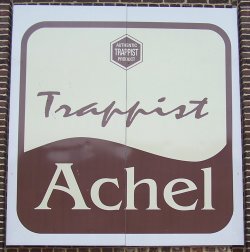
|
While the monastery of St Benedictus is in remote countryside, it is also on popular cycling and walking routes, and visitors quickly spread the news of the Achel beers. As well as the blond and brown beers produced for the tavern, new, stronger brews are now bottled and sold on site as well as in selected shops and bars.
The decision to restart brewing at Achel (pronounced "Arkul") underlined the problems confronting the Cistercian Order of the Strict Observance, better known as Trappists from the name of their first monastery at La Trappe in Normandy. All the monasteries find it increasingly difficult to attract recruits to their demanding way of life. At Achel, since the monks lost their brewery during World War One, they concentrated on agriculture and cattle breeding. But these are hard, unrelenting
jobs and the elderly monks needed an easier occupation. They therefore sold off most of their agricultural land for �300,000 and invested the proceeds in a brewery, tavern, guest house, art gallery and shop.
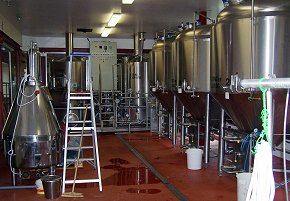
|
|
The small brewhouse, which can be seen from the tavern, has bright, compact vessels built by Moeschle, which can produce 3,000 hectolitres a year. The equipment is based on the continental system of mash
vessel, lauter or filtration vessel, brew kettle where hops are boiled with the sugary extract, and finally five fermentation vessels.
All the beers are matured for a month before being released for draught or bottling.
|
The design and installation of the brewery was overseen by one of the most revered figures in Trappist brewing, Brother Thomas, the former head brewer at Westmalle. He brought a yeast culture with him. When he was taken ill, an equally revered brewer, Brother Antoine from Rochefort, took his place.
The success of the new enterprises at Achel, which take up much of the monks' time when they are not at prayer, has forced them to hand over day-to-brewing to a layman.
He is Marc Knops, a peripatetic brewer at several plants in Belgium, including the famous Domus brewpub in Leuven, under the nose of mighty Stella Artois. Marc spends two days a week at Achel where he fashions
five beers. But he works closely with one of the monks, Brother Jules, who is in charge of brewing in Marc's absence. The International Trappist Association, which awards the seal of "authentic Trappist product" to its
monasteries and convents, insists that monks and nuns must be involved in the production of beer, bread, cheese and other products that are sold commercially.
Pictured right, Brother Jules in the blue overalls keeps things ship-shape with Marc Knops, manning the hose-pipe.
|
|
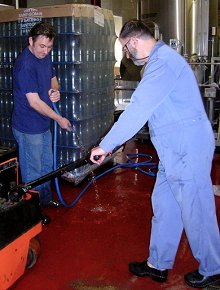
|
While Marc Knops talks of lagering or maturing the Achel beers, they are, in common with all the Trappist beers in Belgium, warm-fermented ales. The blond and brown beers made for the tavern are both 5%, are unfiltered and drawn straight from the brewery tanks. The Blond is brewed from Pils malt and Saaz and Tradition hop varieties. It has a big peppery hop aroma, with tart fruit and juicy malt in the mouth and a long finish with bitter hops, toasted malt and citrus fruit (26-27 units of bitterness/IBUs). The Brown has an addition of roasted malt that gives a rich grainy note to the aroma and a bittersweet palate, followed by burnt fruit, roast and bitter hops in the finish (same IBUs as Blond).
The bottled beers are all refermented in bottle with a different yeast culture. There are two 8% beers, one blond and one brown. Achel Blond is brewed with Pils malt and brewing sugar, Saaz and Tradition hops - the hop varieties are common to all the beers - and 27 IBUs. It has a
pronounced pear fruit nose, juicy malt and spicy hops in the mouth, and a long, quenching finish. Marc describes Achel Brown as "our Bordeaux". Roasted malt and brown sugar are blended with Pils malt. It has
a massive fruit bouquet - raisins and sultanas - along with biscuity malt. The long, bittersweet palate and finish have rich, chewy malt, tart hops and burnt fruit (23 IBUs).
|
|
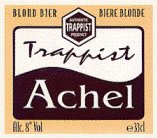
|
Achel Extra, 10%, is a big, magnificent and intensely complex beer. It's refermented in bottle with a different yeast strain to the other beers and has more hops (29 IBUs). The grains are
Pils and roast malt with brown sugar. It has a roasted grain aroma with juicy malt and tangy fruit in the mouth and a long, bittersweet finish that becomes dry, bitter and fruity.
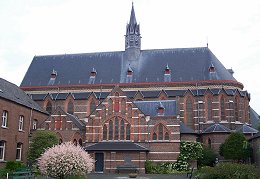
|
|
The monastery started life in 1656 as a simple hermitage and has grown over the centuries into an austere but impressive church that commands the flat landscape and which is surrounded by a complex of mellow brown buildings. Achel's brewing tradition, after a long gap, has been restored and it's to be hoped that the monastery's inscription of Ingredienti Pax - "peace to all who enter here" - will ensure its survival for the future. But, just to be on the safe side, the new brewery is built of stainless steel not copper.
|
Sint-Benedictusabdij de Achelse Kluis
The Auberge is closed on Mondays; open 12-5 Oct-April, 11.30-6 May-Sept. Accommodation available.
Nearest airport: Eindhoven. Nearest mainline train station: Neerpelt, from Brussels Midi/Eurostar, change at Herentals; bus from Neerpelt to Hamont-Achel, then 45 minute walk to monastery. Bike hire recommended.
|
|
home
about
features
A-Z
books
|

